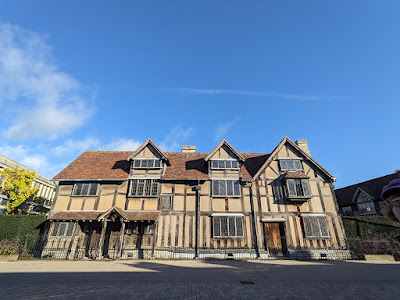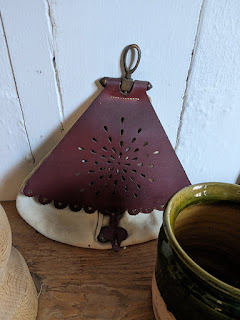We recently visited the U.K., researching schools for the progeny. We put almost 1600 miles on the rental car, visited 7 campuses from Edinburgh to the tip of Cornwall, and splurged on admission to Shakespeare's Birthplace.
There, we learned that Shakepeare's dad was a glover. A prosperous tradesman with several apprentices and a relatively luxurious home. Father Shakespeare was well respected in the community, being named community ale taster. The family was solidly middle class, perhaps even upper middle class. While most paintings and other sources of information on historical fashions focus on the clothing of the elite, the visitor center museum at Shakespeare's Birthplace had an exhibit focusing on clothing of the middle class during Shakespeare's lifetime (1564 - 1616).
Looking at the exhibit, it was striking to see how drastically styles changed during Shakespeare's lifetime. The fashions of the middle class in the late 1500s were totally different from the styles of the early 1600s.
I painted it.
In the late 1500s, both the man and the woman wear wool. Their color palettes are not drastically different. In this example, she wears a camel color overcoat and a burgundy dress. The jacket is cut so that her arms have freedom of movement. She wears a pocket purse on a wide leather belt. Her jacket ties, an easy on / off layered look. Her leather gloves are both stylish and utilitarian. He is wearing a gray jacket with navy blue knee length breeches. He has a thin leather belt. Both seem to be wearing the same style of undershirt with ruffled collar. According to the sign, their outer layers are woolen, while the inner layers are linen. They look like equals. If anything, she looks more powerful, with her purse. It looks like a money pouch for going to the market.
By the early 1600s example, the male and female outfits have diverged to the extreme. The man looks like our classic American image of the Pilgrim. Severe black cloak with silver buttons and big white collar. The woman looks restricted in a structured gown with stomacher, probably over some type of corset and stays. According to the sign, the dress is silk. The man and woman clearly no longer wear the same undergarments. She has lost her utilitarian leather gloves, belt, and pocket purse. They do not look like they necessarily consider themselves to be equals.
I had recently read the book Dress Codes, How the Laws of Fashion Made History, so I was especially intrigued by such drastic changes and immediately considered what within the historical context would have led to the changes. The increasing fortunes of the middle class and the availability of imported fabrics undoubtedly played a role, but it doesn't explain the divergence of male and female dress.
The first other explanation that came to mind was the printing of the Bible in English and the Protestant Reformation. Earlier in our trip we had heard about Tyndale, his English bible and his burning at the stake, as well as about King Henry VIII's English Bible of 1539. Although, after authorizing an English Bible, Henry VIII proceeded to restrict the use of the English Bible to certain social classes - excluding nine tenths of the population. After Henry VIII's reign, Queen Mary cracked down on Protestantism and the English Bible, burning hundreds of reformers at the stake.
Many of the escaped reformers gathered in Geneva, Switzerland, where a sympathetic church was located. There they first published the Geneva Bible in 1560.
"The Geneva holds the honor of being the first Bible taken to America, and the Bible of the Puritans and Pilgrims. It is truly the “Bible of the Protestant Reformation.”" It is also the Bible from which William Shakespeare quoted. (source) It was first published 4 years before his birth, in Switzerland, and from there would have slowly spread.
By 1582, the Roman Catholic Church gave up and also published their own version of the Bible in English.
Concurrently, literacy rates in England soared. "In the late 1400s 10% of men were literate, climbing to 20% in the 1500s, 30% by 1650, 45% by 1714, and 60% by 1754. For women the picture was similar but on a smaller scale: 10% by 1600, 25% by 1714, and 40% in 1754." (source)
The first story in the Geneva Bible is that of the Creation, followed immediately by Eve, the apple, and the expulsion from Eden. From page 6, "Unto the woman he said, I will greatly increase thy sorrows, and thy conceptions. In sorrow shalt thou bring forth children, and thy desire shall be subject to thine husband, and he shall rule over thee." Men and women are clearly not meant to be equal.
Upon reading even more of the Geneva Bible themselves, men like the Puritans decided a God-fearing life was best lived in sober colors, like black. Black was also very expensive, showing one's wealth and prosperity at the same time as one's Godliness. "The somber black of the wealthy Puritan dress stood in stark contrast to the bright and flippant fashion of the British royalty and nobility of the Church of England that the Puritans found godless and immoral. Their black was a clapback of sorts to shame the bright blue taffeta and red silk of the high European fashion of the time." (source) Shakespeare had Polonius advise in Hamlet, "Costly they habit as they purse can buy, but not expressed in fancy; rich not gaudy; for the apparel oft proclaims the man."
According to Richard Thompson Ford in Dress Codes, this was the beginning of "the long trend of sartorial refinement that would culminate in the Great Masculine Renunciation." The Great Masculine Renunciation resulted ultimately in the ubiquitous black business suit.
So why is the woman in red silk? If a godly life is sober....
Ford also writes, "Why was the Great Renunciation masculine? Why did men and only men give up luxurious and glamorous attire, leaving the field of fashion to the fairer sex? In an important sense, they didn't. Instead men only abandoned the cumbersome and increasingly obsolete symbolism of conspicuous ornamentation to women, who would embody this as surrogates for men. Men would still enjoy much of the ancient privilege of opulent display through their wives, mistresses, and daughters, while maintaining enough distance from it to avoid any impression of vanity. At the same time, in place of the older, degraded symbolism of opulence, men adopted new, modern sartorial signs, which they reserved for themselves."
Through the Victorian era and even more recently, "as the men's suit has become ever more streamlined and functional, women's fashions have careened between countless fanciful, dramatic, and beautiful but often impractical styles: layers of petticoats, elaborate bustles, tight-laced corsets, and the drama of ever-changing necklines and hemlines. Of course, this division in the symbolism of attire corresponded to and furthered male chauvinism in politics and the economy: men and only men could present themselves as serious and stalwart, while women were required by law and custom to dress in essentially anachronistic ornate costume, reminiscent of a discredited social order."
Thanks, English Bible and Protestant Reformation.








Comments
Post a Comment